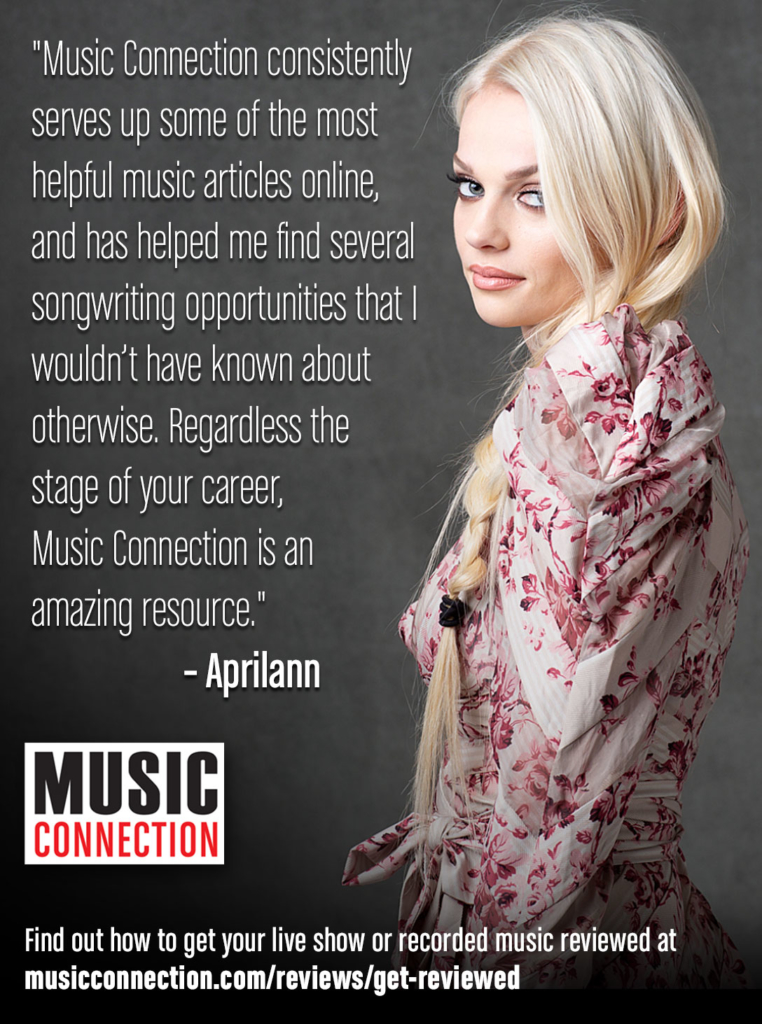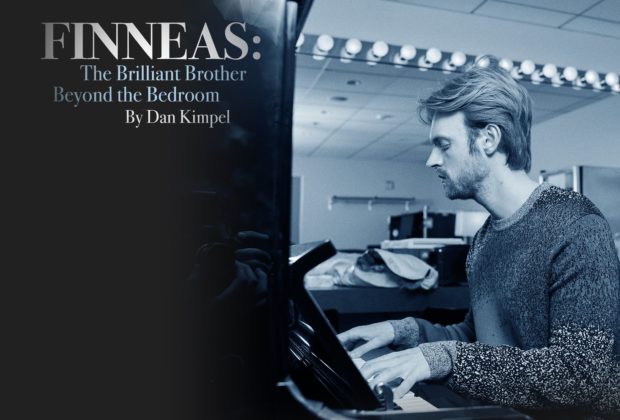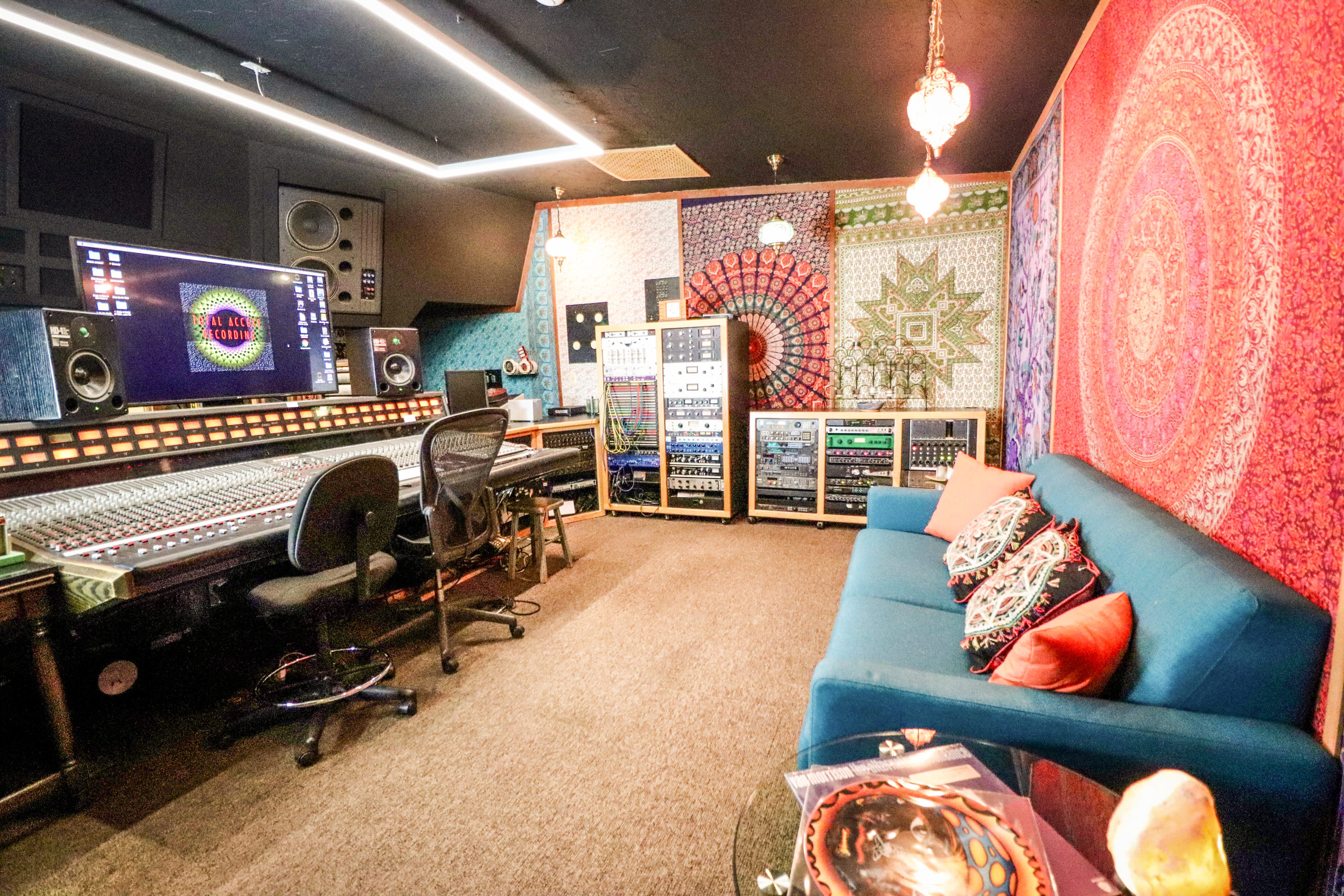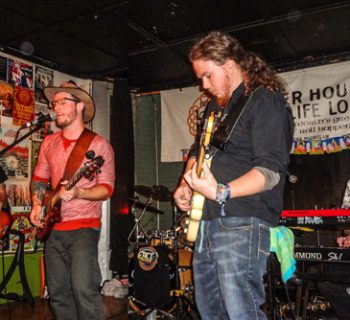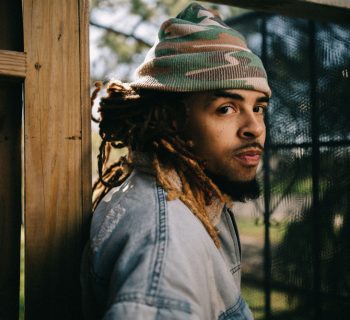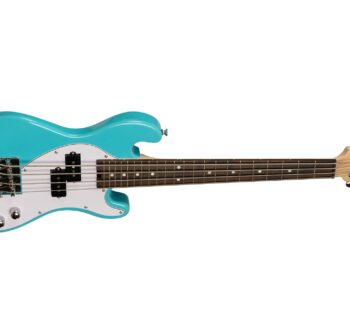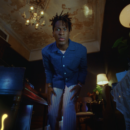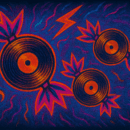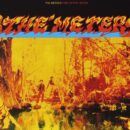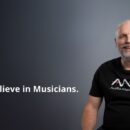As MC goes to press on the cusp of Grammy season, producer, songwriter, and performer Finneas O’Connell, née FINNEAS, is nominated in four major categories: Best New Artist, for his solo project Optimist, and in collaboration with his sister Billie Eilish, Album of the Year for Happier Than Ever, and Record of the Year and Song of the Year for the collection’s title track.
No stranger to the Grammy podium, FINNEAS previously clutched six statuettes at the 63rd Annual Awards, when, at 22, his peers voted him the youngest ever honoree for Producer of the Year, Non-Classical. Last year, two additional Grammys were bestowed with Eilish’s “Everything I Wanted” named Record of the Year, and “No Time To Die” from the James Bond film of the same name taking Best Song Written for Visual Media.
In 2017, prior to the release of her Grammy-winning full-length debut When We All Fall Asleep, Where Do We Go? MC interviewed Billie Eilish for an exclusive cover story. That same year, we featured a Song Biz Profile with FINNEAS, as we chronicled the remarkable Cinderella tale of the spectacularly successful siblings from Highland Park, Los Angeles.
Branching out as a producer and a songwriter, FINNEAS has blossomed with a prolific string of projects for artists including Camila Cabello, Tove Lo, Kid Cudi, and Ben Platt—plus collaborations with Ashe and Ringo Starr.
At 24, although much has changed in the world of FINNEAS, his humanity, humility, and clear-eyed devotion to music remains resolutely intact.
Music Connection: As we observe the many styles of producers who historically have made a massive pop impact, there are those who are identifiable with distinctive trademarks. What we note from your production is transparency, allowing the artist to shine through.
FINNEAS: I’m honored that you would say that. My utmost goal and fantasy is that you’re listening to some record and you say. “This is my favorite album ever—who produced this?” And you look it up and it would be me. And then you would listen to a completely different genre of music and go “Wow. I love this album too, who produced this?” And it would also be me. I’d love to have a sound that is unrecognizable and doesn’t shroud the artist. I would like to make music for artists that is consistently good, but doesn’t have much of my fingerprint on it.
MC: Historically, pop music producers who are tied to specific eras and genres have briefer shelf lives.
FINNEAS: That’s part of the reason I care about it so much. The producers I loved growing up, those that lasted the longest, were like chameleons. The producers who were great but had signature sounds often had short, spectacular careers.
MC: Who did you listen to production-wise as you developed your approach?
FINNEAS: As a young kid it was Butch Vig and Rob Cavallo. I was a big fan of the Max Martin ethos. Also, Ludwig Göransson from his work with Childish Gambino, plus Pharrell and Timbaland.
MC: You came up recording in a bedroom in Highland Park where you created massive hits on consumer grade equipment.
FINNEAS: I’m now consumer grade for another reason—the speed. The easiest equipment to use is often the fastest. I’m trying to articulate my idea in the quickest way possible. If I turn on a microphone and have to wait 15 minutes for the tube to heat up, or turn on a preamp and dial it in, I’m already bored. I’d rather just turn it on and get the idea down.
MC: What program are you using for recording?
FINNEAS: Logic Pro, which has only just gotten better over the years. It has unbelievably improved from the day I started using it. The new sampler engines and the drum machine designs are so incredible. I use ATH-M50X headphones by Audio-Technica, also consumer grade. I listen to a lot of music on AirPods.
MC: You’ve built a studio in your new home in the Los Feliz neighborhood of Los Angeles, correct?
FINNEAS: What I actually did was: I made a room sound really good. I had to do sound treatment. The room in Los Feliz didn’t sound as good as my childhood bedroom, which sounded really good. There was enough stuff: sheets, bookshelves full of books, and a bed. It was nice and quiet and I was trying to replicate that. I don’t have a Neve console, or an isolation booth or anything like that.
MC: On your new project, Optimist, the preceding singles and the EP Blood Harmony, you produce yourself. How do you divorce the artist from the producer, or do you?
FINNEAS: Good question. I feel like as a producer I’m listening to myself as an artist, a songwriter, and a singer. I’m seeing what makes the most sense, and what is the most believable, and what feels the most authentic. I’ve been able to make some really cool productions for Billie, for Tove Lo, Selena Gomez, Camila Cabello, and those are artists are authentically themselves. And if I tried to do what those artists do, you’d think I was playing pretend. I rely on my own sensibilities as to what feels genuine as an artist for me.
MC: One of your sonic trademarks with Billie is that somewhere on the track there is a sound almost like a ticking. What does that represent?
FINNEAS: I think it’s a tendency of mine to give things a heartbeat—the ticking could be a high noise or a sub bass that’s undulating. I like to have a forward motion component in music that’s not a kick drum and a snare drum and a high hat, something that’s unorthodox and surprising.
MC: One of the trademarks of Billie’s work, and also something we hear on Optimist, is a hushed vocal tone, very soft and intimate. What are your criteria for making something sound small, as opposed to huge?
FINNEAS: I think it all comes down to the song, but intimacy makes the scope and size of large things even larger. Dynamics are reliant on the dynamics—if that makes sense. So, if you have an album that’s all at a 10, how can you have an 11? But if you have one that goes from one to five and then back again, when it goes to 10 it feels enormous.
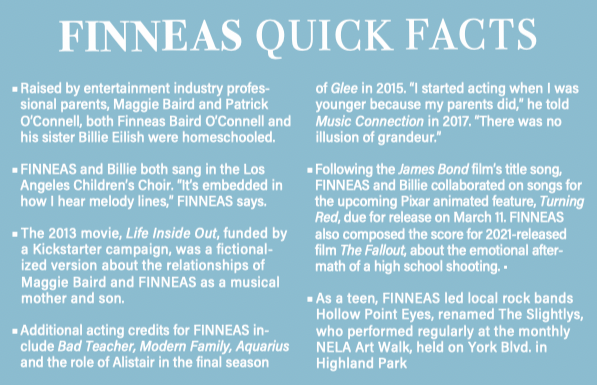
MC: Speaking of size, when we look at the Grammy nominated projects, there are immense lists of songwriters and producers. When we see the listings of collaborators for you and Billie, it’s essentially just the two of you, plus mixing and mastering personnel.
FINNEAS: Isn’t that cool? But I’m in the army of people who made the Justin Bieber album Justice. I’m lucky to be there too. I don’t think there’s a right way or a wrong way to make an album.
MC: The Justin Bieber song on which you collaborated, “Lonely,” really captures the disconnecting vibe of celebrity. Benny Blanco is a major contributor as well.
FINNEAS: That song would not exist without Benny Blanco. Benny has a long history with Justin, and he has done several of Justin’s best songs, in my opinion. Benny and I are close. At some point he suggested that we write something for Justin. This was at the end of 2019 or the beginning of 2020. We talked about how incredibly isolating it would be to occupy a place where Justin is, a place of experiencing something that no one else has gone through. Being a one of one. Most of life, and most of empathy is based on our common ground, our common experiences. Very few people have experienced the life that Justin has. I adore Benny and we’ve now written a lot more stuff.
MC: In certain historic styles of pop music—especially Motown—every instrument was formulated as its own hook. Many of your productions also have multiple instrumental hooks, as well.
FINNEAS: As a producer I’m trying not to get lost in the minutia of something until that’s all that’s left. My worst fear is that I’ve overlooked a mediocre song and mediocre vocal and I’m spending six hours worrying about the sound of the kick drum. Everything else has to be in place and substantive and of quality—then I’ll worry about the kick drum. From an instrumental component I care a lot about it. But I want everything else to be perfect.
MC: Seemingly the line between songwriting and production is a bit blurry for many writer-producers. Do you see a separation?
FINNEAS: I started writing songs in a pure melody-chords-lyrics fashion, because I had no experience in production. I graduated to producing the songs after I’d written them. I do find it helpful to produce songs a little bit when I’m writing. It will help inform more rhythmic lyrics and melodies. I’m reluctant to produce a beautiful instrumental and then write a mediocre song over it. I’d rather make sure I’ve written something really good and then worry about the instrumental.
MC: One of your trademarks as a producer is placing acoustic instruments in the center of the sound. On one of your new solo songs, “A Concert Six Months From Now,” the guitar has a street busking tone.
FINNEAS: I love the simplicity—the way a piano sounds, an acoustic guitar, and I love them when they are paired with surprising elements. That to me is an exciting marriage: a traditional element with this shocking thing.
MC: We read a quote from you that we will paraphrase: You noted that music that becomes enormously successful generally doesn’t sound like anything else.
FINNEAS: I think that’s true. The exception to that rule is the greatest songs. A magnificent piano ballad will become big because it’s terrific—it doesn’t matter that we’ve heard a million of them. When “Someone You Loved” by Lewis Capaldi blew up, I was thrilled.
MC: You made Grammy-winning albums in your bedroom, and you now work primarily at home. Do you also work in conventional studios?
FINNEAS: I’ve been in all the great ones in L.A. at least once. What I like to do is to be where artists are their most comfortable. Sometimes an artist is locked into Conway Recording Studios for a month straight, and I’ll go there to work with them. I’m the most comfortable here at my house; Billie is her most comfortable when we’re at home together. So that’s where we stick to working. If I’m working with someone I don’t know as well, maybe we’re working together for the first or second time in the studio, a separate location is a plus. They’re not in your house or you’re not in their house. I don’t make anything better in studios, but sometimes it’s nice to work in a place that isn’t your own bedroom.
MC: Happier Than Ever, Billie’s latest album, was created during the pandemic lockdown. You were on a regular creative schedule, correct?
FINNEAS: Yes, we worked three days a week. That’s how we made the album. It was our mom’s idea, and so smart. When she suggested it, we were like “No!” But we tried it out and made the song “My Future” immediately.
MC: When you are producing vocals for other artists, do you ever have to be a psychologist?
FINNEAS: Sometimes. You have to make the artist feel safe. Otherwise, no one is going to do their best work. We aren’t as vulnerable around our closest friends as we need to be around our creative collaborators. We need to be really vulnerable—I mean therapist vulnerable. And that can be a challenge.
MC: Do you ever have to challenge a vocalist?
FINNEAS: I hope I’m challenging a vocalist every time in terms of making sure that I’m holding them to the highest standard. I feel like it should be a goal to make someone do the best they’ve ever done. To me it’s about inspiring an artist to challenge themselves rather than make them feel like I’m pushing them.
MC: What mics are you using for vocals? And what is Little Altar Boy?
FINNEAS: I spent years with a Neumann TLM 103, now I use a Telefunken 251 for Billie, and a Chandler REDD for myself and with others. Little Altar Boy is an amazing plugin made by Sound Toys. It can be used on anything, but I primarily use it on vocals. It’s a processor that shifts pitch and tone and can distort sounds.
MC: Are there other new instruments or effects in your arsenal?
FINNEAS: I use a synthesizer called an Ace Tone TOP-6, an old Japanese synth that I bought from Custom Vintage Keyboards that has a great sub bass.
MC: You play guitar, keyboards, and other instruments on stage and in the studio. Do you consider yourself an accomplished instrumentalist?
FINNEAS: I don’t feel super-qualified. I don’t think I could rip a solo. I can offer support. I can pick something up and be musical with it, but I’m not virtuosic.
MC: In concerts with Billie, you are often performing on bass. It makes the overall sound more organic.
FINNEAS: Bass to me is the thing that goes the best with vocals, they don’t infringe with each other. I play guitar and keys onstage with Billie, but my favorite thing is bass. I use a Fender Mustang—it’s got a “subbier” tone and a short scale neck, which fits me better. I’m six feet tall...bassists are all six foot five!
MC: When you were presented with one of your many Grammy Awards, you dedicated it to the kids who are making music in their bedrooms—what you did at your folks’ house here in Highland Park.
FINNEAS: I definitely felt empowered. Now it’s par for the course. Everyone is making music at home.
